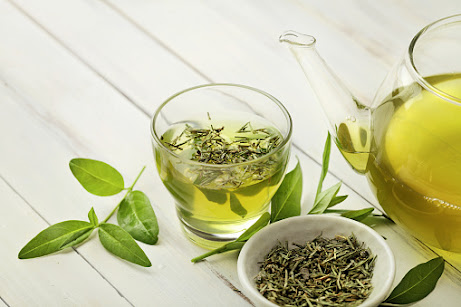What is Green Tea
Green Tea
Tea is one of the most popular drinks in the world. Camellia sinensis tea is consumed as green, black or oolong tea in many parts of the world. However, among all these, the most significant human health effects were observed from green tea consumption [17]. The first green tea was exported from India to Japan in the 17th century. It is estimated that around 2.5 million tonnes of tea leaves are produced annually worldwide, 20% of which is green tea, which is consumed mainly in Asia, parts of North Africa, the United States and Europe. The relationship between tea consumption, especially green tea, and human health has long been known [19,20]. Green tea and black tea are processed differently during production. To make green tea, the freshly harvested leaves are brewed immediately to prevent fermentation, creating a dry and stable product. This brewing process destroys the enzymes responsible for breaking down the color pigments in the leaves and allows the tea to retain its green color during the subsequent rolling and drying process. Through this process, natural polyphenols are retained in terms of their health promoting properties. Since green tea is fermented into oolong and then into black tea, the polyphenol compounds (catechins) in green tea are dimerized into various theaflavins, so the teas can have different biological activities.
Green tea ingredients
The chemical composition of green tea is complex: protein (15-20% dry weight), enzymes which are an important part; Amino acids (1-4% dry weight) such as theanine or 5-N-ethylglutamine, glutamic acid, tryptophan, glycine, serine, aspartic acid, tyrosine, valine, leucine, threonine, arginine and lysine; Carbohydrates (5-7% dry weight) such as cellulose, pectin, glucose, fructose and sucrose; Minerals and trace elements (5% dry weight) such as calcium, magnesium, chromium, manganese, iron, copper, zinc, molybdenum, selenium, sodium, phosphorus, cobalt, strontium, nickel, potassium, fluorine and aluminum; and traces of lipids (linoleic and -linolenic acids), sterols (stigmasterol), vitamins (B, C, E), xanthine bases (caffeine, theophylline), pigments (chlorophyll, carotenoids) and volatile compounds (aldehydes, alcohols, esters) ) , lactones, hydrocarbons). Due to the importance of mineral content in tea, many studies have determined its content in tea leaves and infusions. Fresh leaves contain an average of 3-4% of the alkaloids known as methylxanthines, such as caffeine, theobromine, and theophylline. In addition, phenolic acids such as gallic acid and characteristic amino acids such as theanine are present [22].
To read more about green tea benefits and side effects check out this article.

Comments
Post a Comment